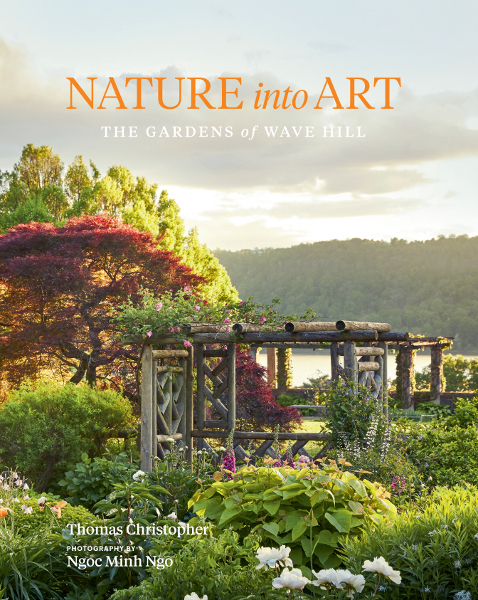
photography by Ngoc Minh Ngo, image courtesy Timber Press
.
If you have any comments, observations, or questions about what you read here, remember you can always Contact Me
All content included on this site such as text, graphics and images is protected by U.S and international copyright law.
The compilation of all content on this site is the exclusive property of the site copyright holder.
Nature into Art, The Gardens of Wave Hill, a book review
Friday, 18 October 2019

photography by Ngoc Minh Ngo, image courtesy Timber Press
Have you ever visited Wave Hill? It's a superlative garden in the Bronx, overlooking the Hudson River, across to the Palisades of New Jersey. If, for whatever reason you've never been there, Nature into Art, The Gardens of Wave Hill by written by Thomas Christopher and photography by Ngoc Minh Ngo will have you adding a visit to your bucket list.
Once upon a time, Wave Hill was a country estate. The Perkins family had notable house guests, such as mark Twain, Theodore Roosevelt, Arturo Toscanini. In 1960 family heirs, the last private owners of the family, donated the 28 acre property to the City of New York. And there things stalled for a while. There wasn't much money for horticultural acquisitions and property maintenance. Marco Polo Stuffano, graduate of the New York Botanical Garden's School of Professional Horticulture was hired as the founding director of horticulture. And it was here that Wave Hill's foundation as one of the world's preeminent gardens was begun. Nature Into Art begins here with some history of the site and principles of design for a garden that grew, incrementally and organically, developed with the plants rather than pencil on paper.
Let's follow the book as it tours the grounds.

photography by Ngoc Minh Ngo, image courtesy Timber Press
Harmonies and counterpoints are central to the Flower Garden's display.
Text explores the history of the garden, explaining the use of annuals, in early years, raised from seed. Some were discovered to re-seed, and now the use of self-sowing annuals is an important factor in several of the gardens. The pleasant text is enhanced by a few historical pictures but graphically brought to life with vistas and overviews, and plant portraits. Delightful, informative details - biennials such as foxgloves are started in cell packs in mid-to late July, overwintered in cold frames outdoors, dropped into the garden in late fall as fading plants open up spaces. In turn, as they finish flowering, the foxgloves are hoicked out, replaced by dahlia tubers, gladiolus corms, tender salvias in mid- to late June to provide late summer and fall color. Labor intensive, spectacular results.
There's a chapter on The Gold Border - and don't think monochromatic equates to dull. The Monocot and Aquatic Gardens (adjacent to each other at Wave Hill) are next. There is a page here and there with suggestions for caring for aquatics, and gardening with tropicals, and what the home gardener might do.

photography by Ngoc Minh Ngo, image courtesy Timber Press
The shade border offers options and possibilities for country gardens where shade comes from trees. It also provides ideas for city gardens where buildings create the lower light conditions. Text explains, discusses, offers some definitions for shade, while the images of trees, shrubs, perennials, native wildflowers will whet the reader's appetite for plants that thrive in shaded conditions. How to plant, using fertilizer, when and how to water increase the chances of success.

photography by Ngoc Minh Ngo, image courtesy Timber Press
If I had to choose just one part of Wave Hill's gardens it would probably be the Wild Garden. There you stand at the top of the slope, at strategic points along the twisting paths looking out across the Hudson Rover at the forested Palisades. Continue along a path, it curves away. You lose the vista but view the plants growing in casual tousled abundance. Some shrubs, other perennials, and self-sowing annuals and biennials planting themselves where they want to grow. There are many spring ephemerals, bulbs that come and bloom and disappear. Text explores the influences that factored in to this garden's concept, and the maintenance that staff discretely provides.
Alpine House and Troughs. An alpine house is a place for growing select high mountain plants that need the barest modicum of protection, and able to be viewed by the public. Hypertufa, an amalgam of Portland cement, perlite, and peat moss is used to create troughs for planting miniature landscapes kept outdoors. Where and how Marco Polo Stuffano became not merely fascinated but convinced this could be done at Wave Hill. There is so much detail offered in this chapter even including the recipe for making hypertufa, the recipe for alpine plant soil mix. This chapter could be a little book all on its own. In fact, so could the other specialty garden chapters: the Herb and Dry Gardens, Annual Plantings, Elliptical Garden,
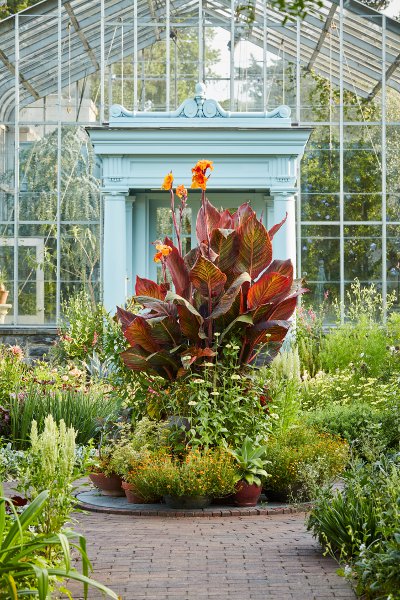
photography by Ngoc Minh Ngo, image courtesy Timber Press
There is another conservatory, with one wing for begonias and tropicals, another wing of cacti and succulents, and a wonderful central display house with a rotating array of what's spectacular at the moment.
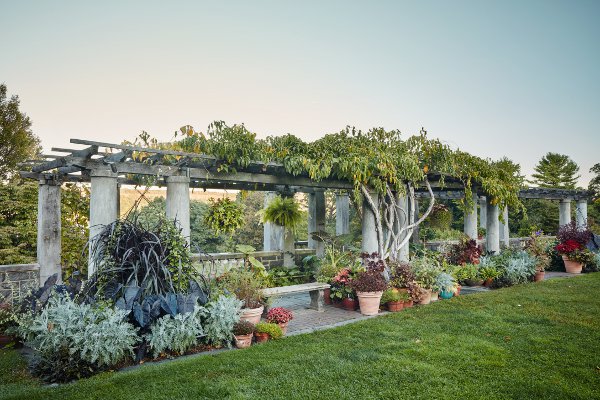
photography by Ngoc Minh Ngo, image courtesy Timber Press
A garden is not static. Growing, it includes the fifth dimension of time. The concluding chapter, Wave Hill Through The Seasons offers readers a glimpse of the multiplicity of plants and seasons, vistas and enchantment. Walk on the grass. It's allowed. Do smell the flowers. And enjoy the history and magic that grew into a garden which has spread its influence far beyond its actual boundaries.
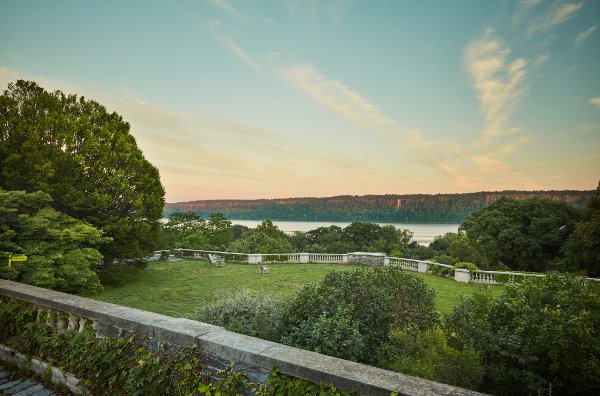
photography by Ngoc Minh Ngo, image courtesy Timber Press
In the interest of full disclosure I should tell you that my first visit to Wave Hill was multiple decades ago, with multiple return visits since then. In fact, at one point when I was teaching twice a week at the New York Botanical Gardens I would, after class, travel to Wave Hill before reversing direction to go home. About the sixth or eighth visit, third or fourth week in of this six week hejira Marco would look at me and exclaim, "What! You here again?" Indeed. And back as often as I can manage. I think even if I came every day there would still be something new to see in the gardens of Wave Hill..
Make a visit at any season - late into the fall
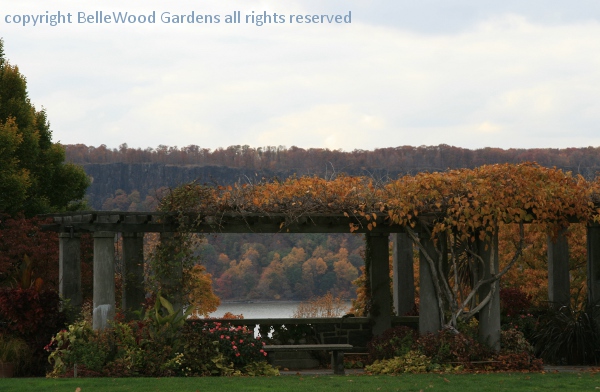
or end-of-winter, not-yet-spring,
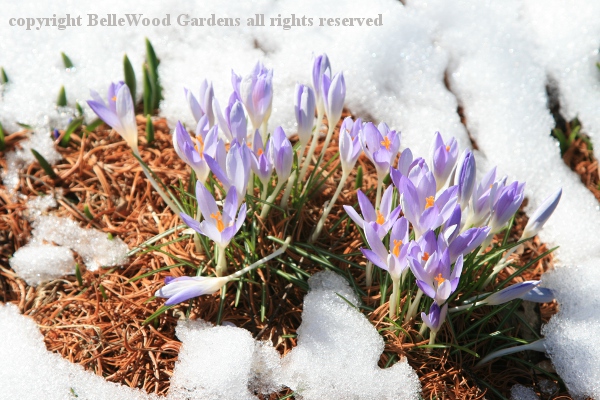
to enjoy, because the Gardens of Wave Hill are indeed Nature Into Art.
And until you do visit in person, make a virtual visit
through the pages of this informative, attractive book.
Nature Into Art, The Gardens of Wave Hill
by Thomas Christopher, photography by Ngoc Minh Ngo
Published by Timber Press, Portland, Oregon, 2019
ISBN 978-1-60469-851-0, hardcover, $40.00
A review copy of this book was provided by the publisher
Back to Top
Back to October 2019
Back to the main Diary Page